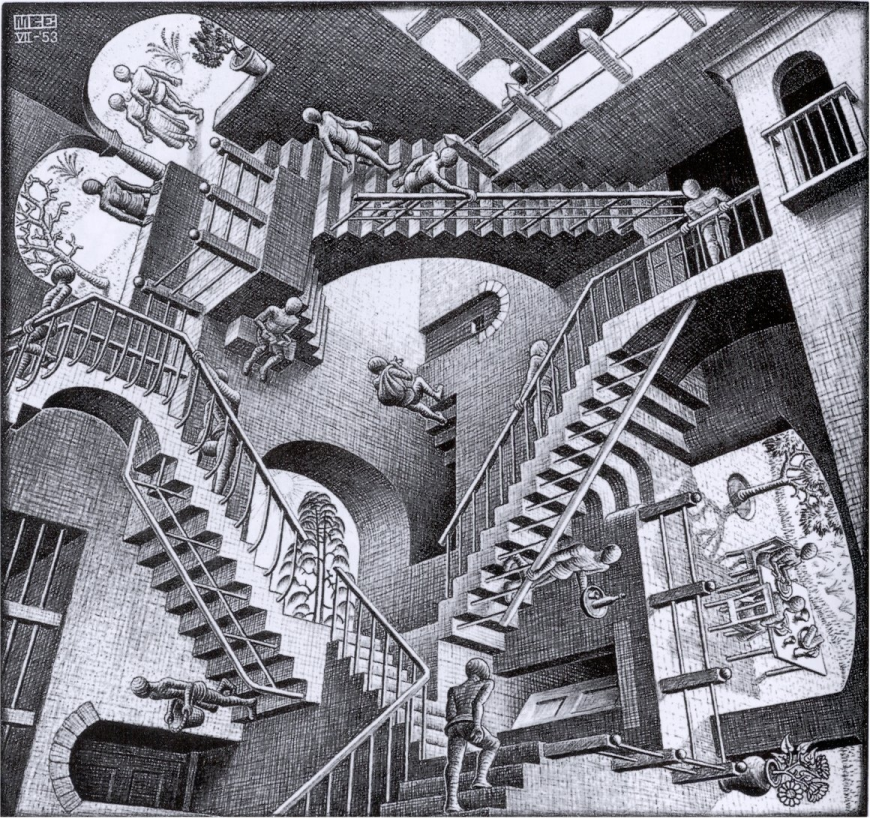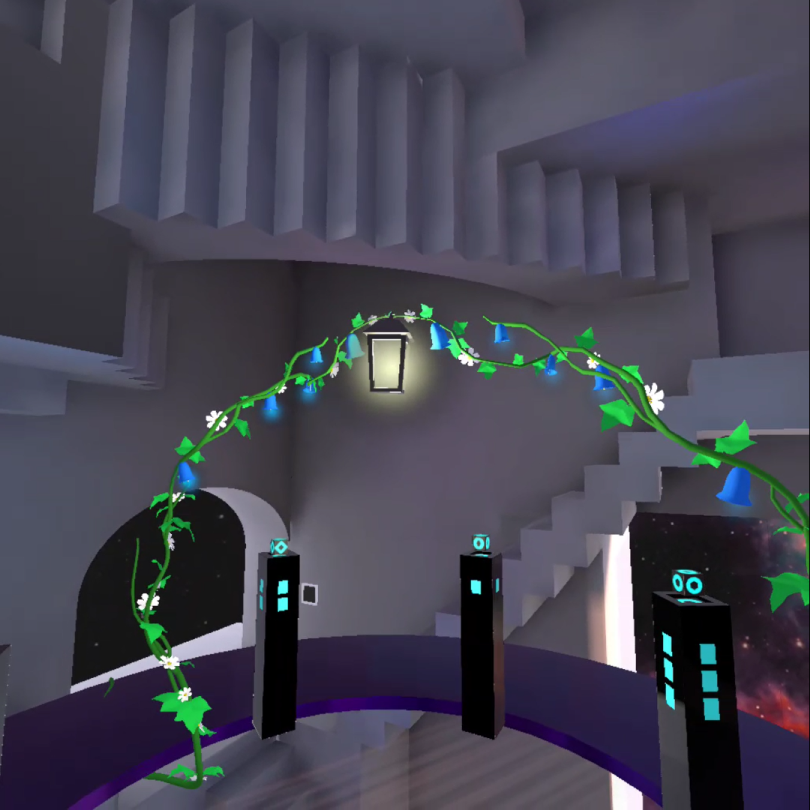Spaces
Designer
Spaces is a VR perspective puzzle game based on M.C. Escher’s “Relativity” drawing. Players navigate this impossible space to match their perspective to the perspective shown in a series of pictures.
apk for Oculus Quest- TYPE
- Digital Arts
Capstone Project
Jump to prototypeROLE
3D Modelling: I creacted the 3D model of the room based off of M.C. Escher’s drawing. I also modelled elements such as the flower vines and lantern that appear as players progress through the puzzles.
Animation: I animated the flower vines to “grow” as players completed puzzles in order to add delight and signify progression in the game.
Lighting: I added colored point lights and light shafts to the room to create to a serene calm environment that made the experience feel polished and complete.
CHALLENGE
How might we create something in VR that takes full advantage of the technology in a way that allows a player to experience something they would not be able to in the real world?
For our capstone project in the Digital Arts Minor, we was given free reign to create anything within the realm of digital arts in 10 weeks. My partner and I spent the first few weeks brainstorming project ideas that ranged from 2D animations to interactive immersive VR storytelling. Since we were both interested and had experience in creating VR apps. we decided to challenge ourselves to take full advantage of VR’s capabilities and make something unique.
IDEATION
Our initial idea was to weave storytelling into an escape room experience. Players would find clues in an old hut and discover the life of the person who used to live there. These clues would hint at how this desolate wasteland you find yourself in came to be. While planning puzzles for players to find in this hut, my partner and I stumbled upon M.C. Escher’s “Relativity” drawing. We were inspired by this drawing to incorporate a perspective shift into a puzzle where a players had to walk on the ceiling to realize a painting on a wall contained an upside-down clue.

After designing a few more puzzles we realized that most of what we had were just a VR version of a real escape room. We wanted to lean into the affordances of VR and our idea wasn’t accomplishing that goal. We found that this play on perspective that we had stumbled upon was easily the most compelling component.
After some more brainstorming of how we could incorporate more perspective shifts into our app and hitting dead ends, we realized—what if we stripped everything else away and only focused on this idea of perspective? What if we just brought Escher’s drawing to life instead? This way, we can leverage VR technology to allow players to experience something that would be otherwise impossible in the real world.
Bringing Escher’s drawing to life would allow players to physically move about an impossible space and experience the perspective changes that “Relativity” captures.
GAMEPLAY
To add another layer of engagement, we wanted to encourage players to navigate about the space rather than simply observe it. So, we created simple perspective puzzles where players are given a series of photographs, taken from various locations in the room. Their goal is to find where in the room those photos were taken.

When the player has located where a photo was taken, an picture frame appears near them. Once they place the photo in the frame, the picture is replaced with a 2D cube. The player can then reach into the frame to pull out the 2D cube which materializes into a 3D object. Holding this cube, the player navigates back to the center where they place it on an empty podium. This action triggers a flower vine to grow and the next photo to appear. players to experience something that would be otherwise impossible in the real world.

Bringing Escher’s drawing to life would allow players to physically move about an impossible space and experience the perspective changes that “Relativity” captures.

After completeing all five puzzles, a portal appears between the flower vines. Going through this portal brings the player to another interesting space with more puzzles (coming soon!)
TAKEAWAYS
My partner and I set out to create a VR experience that used the technology in a worthwhile and meaningful way. We didn’t want VR to feel gimmicky or that we were building something in VRfor the sake of building something in VR. It was definitely difficult for us to brainstorm with the affordances of this technology and what we could leverage it to do that would not be possible in the real world.
This project really pushed me in my 3D modelling abilities having to construct the impossible space based off a single image. I spent countless hours starting at Escher’s drawing, aligning edges,and welding vertices. I also pushed myself to understand lighting as I wanted the space to feel as visually polished as possible. Through an assorted collection of point lights, spot lights,particle systems, directional lights and many many renders, I gained a better understanding and appreciation for how important and difficult lighting is.
I learned that making something that seems simple is in fact very difficult, but I was able to learn so much along the way. It was definitely not a straightforward path to get to our final product, but I am proud of the work we’ve accomplished in just 10 short weeks from ideation all the way to implementation.



